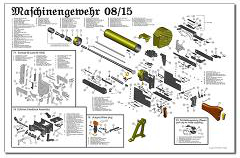Main Menu

Das Maschinengewehr 08/15
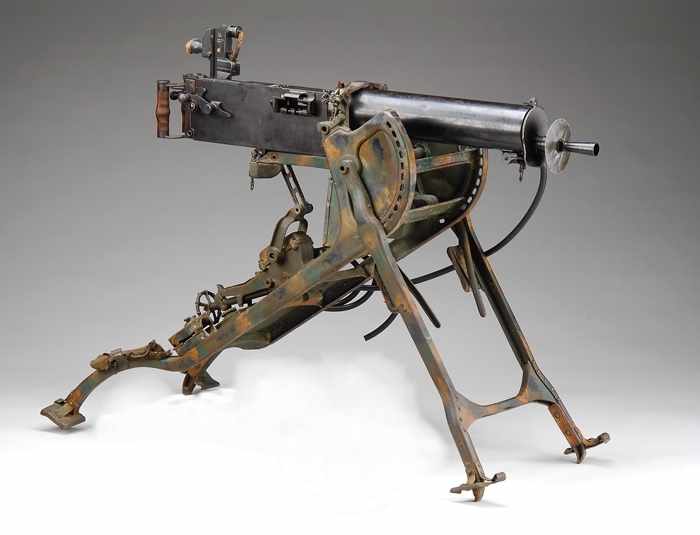
Maschinengewehr 08 mit Schlitten
The Maschinengewehr 08, or MG08, was the German Army's standard machine gun in World War I and is an adaption of Hiram S. Maxim's original 1884 Maxim Gun. It could reach a firing rate of up to 400 rounds per minute using 250-round fabric belts of 7.9mm ammunition. It was water-cooled using a jacket around the barrel that held approximately one gallon. It operated on the basis of short barrel recoil and a toggle lock; once cocked and fired the MG08 would continue firing rounds until the trigger was released (or until all available ammunition was expended). Its practical range was estimated at some 2,000 meters (2,200 yd) up to an extreme range of 3,600 meters (3,900 yd). The MG08 was mounted on a sled mount (German: Schlitten) that was ferried between locations either on carts or else carried above mens' shoulders in the manner of a stretcher.
Despite the success of the Maxim 08 MG on the battlefield, it became apparent that a lighter, less cumbersome weapon would be a great advantage. The British deployment of their air cooled Lewis LMG was particularly effective, allowing the rapid relocation of defensive MG support in the close confines of the trenches of the Western Front. The French also sought to develop a light automatic weapon (the Chaut Chaut) a magazine fed, air cooled machine rifle which could be operated by a single soldier.
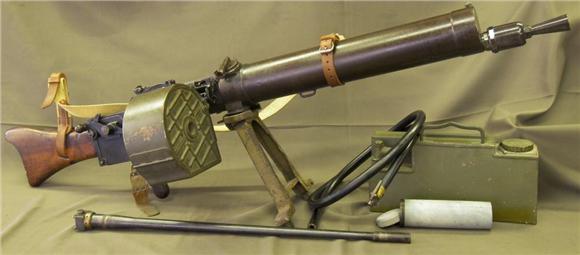
MG 08/15 displayed with shoulder sling, bipod, drum, steam hose, steam chest, spare barrel and booster soaking can.
Developed under the direction of Colonel von Merkatz, the new, portable automatic weapon that emerged was christened the MG08/15. This design paradigm, by which the standard heavy machine gun was adapted so as to provide a portable version, was in marked contrast to the path taken by the Allies. The Allied armies adopted a number of light automatic weapons that were not at all adaptations of their heavy types. In doing so they undoubtedly managed to adopt much more efficient designs, but at the cost of overall production efficiency. The German decision to stay with the Maxim design simplified both production and training.
This "new gun" functioned the same in its firing cycle, provided the same rate of fire, used the same ammunition, belts and many internal parts. It also maintained the same reliability as the older '08 and required little retraining to operate. It was lightened to the extent where the gun could be advanced with attacking soldiers, but the MG08/15 had a number of key differences from the standard 08:
- All provisions for trench armor often found with the '08 were done away with.
- The diameter of the MG08/15's water jacket was smaller by some 20mm than that of the MG08 (89mm vice 109mm). As a result the volume of cooling water inside the jacket was reduced from four to three liters.
- The thickness of the receiver walls was reduced from 4mm to 3mm.
- The ejector tube was eliminated.
- The sled mount was replaced by a bipod.
- The spade grips and thumb triggers were replaced by a wooden buttstock fixed to the rear of the receiver.
- A pistol grip with a conventional trigger was added under the receiver. The trigger acted directly on the trigger bar. A safety was fitted that, when applied, prevented the trigger from moving.
- They also removed the mount for the ZF12 telescopic sight and completely revised the rear sight.
- A sling was fitted for carrying and for assault fire.
In addition, a new booster/flash hider was introduced, providing for a much more positive recoil action.
A provision was made for introduction of a 100 round ammunition drum to be hung on the side of the receiver. The crew required was reduced from 5 to three with capability for operation by a single gunner.
Unloaded (but with a full water jacket) the MG08/15 weighed in at a healthy 19 kg (42 lbs).
By 1916 it was being fully deployed throughout the German lines. It was instrumental in the disaster of the Somme, at times cutting down advancing British troops in windrows much like they were wheat.
Over 130,000 08/15's were produced during the war, which resulted in one other dubious fact that should be related. It is singularly responsible for more causalities on the battlefield than any other weapon ever deployed, including the Atomic Bomb. It has truly earned the reputation of the Devils Paint Brush.
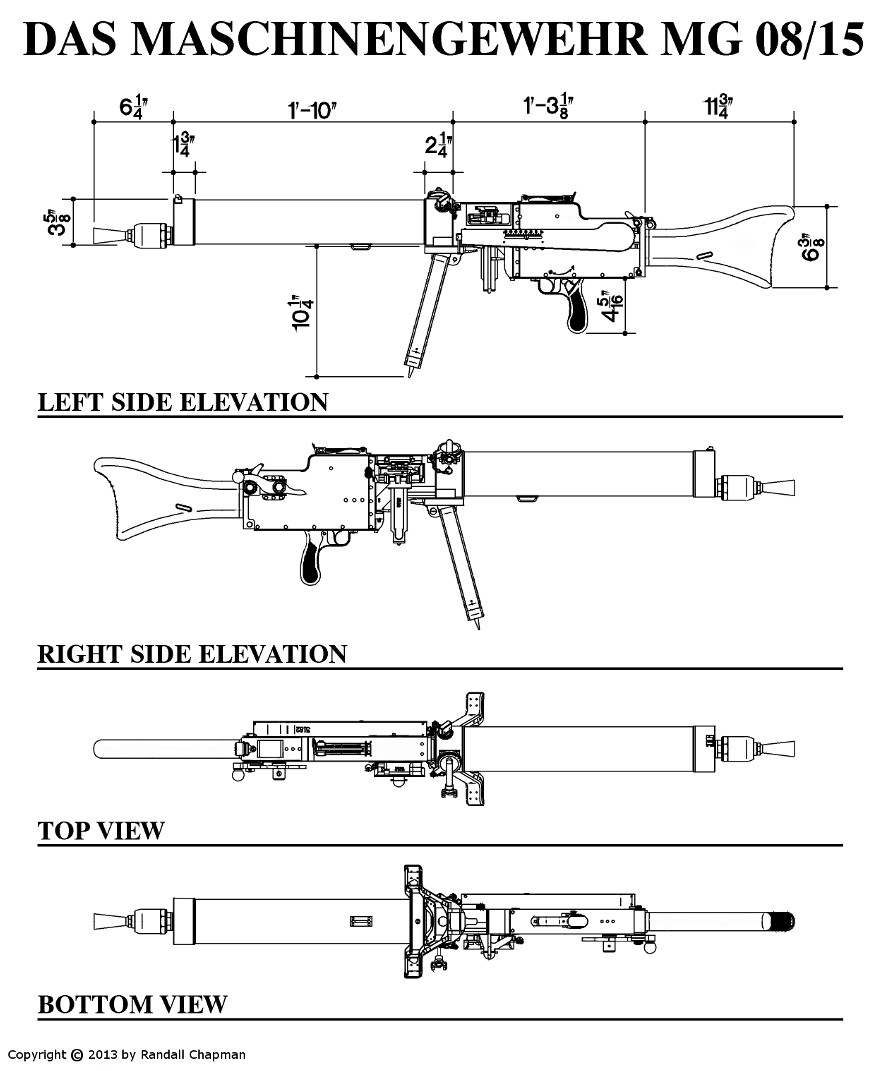
Many today, unfamiliar with the MG08/15, assume it was too large and heavy to use as an assault weapon, but that is not the case. The MG08/15 was designed to be an assault weapon, which meant it could be moved forward with advancing troops and fired on the move - as seen in the period photo below right. Training included instructions on the proper stance to hold and fire the MG08/15 on the move, as seen in this photo below left. The soldier depicted is most likely a Reichswehr-era Soldaten, but he is wearing similar gear to the WWI soldier, including gas mask and assault pack. Interestingly, the booster appears to be a military blank-fire device.
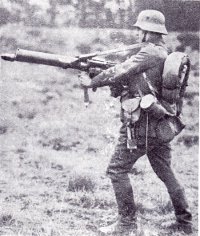
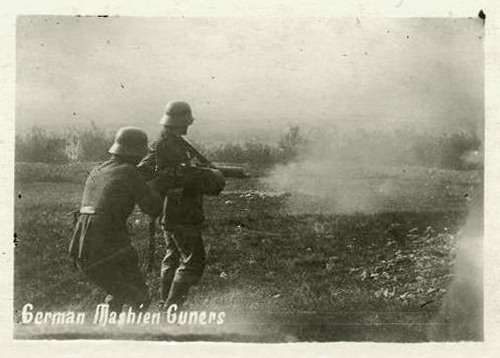

The MG08/15 had been designed to be
manned by four trained infantrymen
spread on the ground around the gun and in the prone
position. To accomplish that purpose, the MG08/15 featured
a short bipod rather than a heavy four legged sled mount, plus a
wooden butt stock and a pistol grip. The bipod
could be quickly attached/detached via a spring loaded latch and
the legs were equipped with spikes to plant firmly in the ground. The
bipod swiveled so that once planted, it could easily be panned to provide a wide arc
of fire. There were multiple designs, but
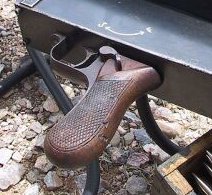 modern reproductions match the original pictured left and are encouraged for use as to save originals from wear and tear.
modern reproductions match the original pictured left and are encouraged for use as to save originals from wear and tear.
The pistol grip was equipped with a safety that could quickly be flipped with the thumb.
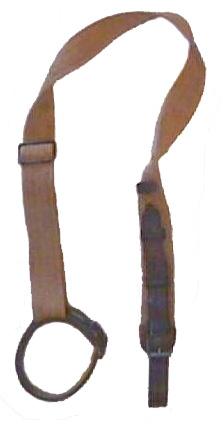
Since the MG08/15 was an assault weapon, it was equipped with a Schulterriemen (shoulder sling). They were at first, made of leather but as the war dragged on material shortages saw cloth webbing used for the long portions with leather used for the high-stress attachment point. The picture at left shows this cloth/leather sling by itself, below as installed on the weapon.
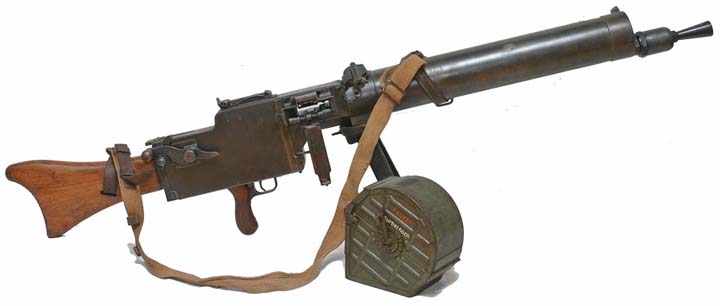
The MG08/15 booster consists of three main pieces; the flash hider, the bell and the main body. This booster was a considerable improvement over the earlier MG08 style booster. This revised booster eliminated the need for a muzzle fitting, which allows the removal of the barrel without disassembling the booster. The bell replaced the circular disk for hiding the booster's flash.
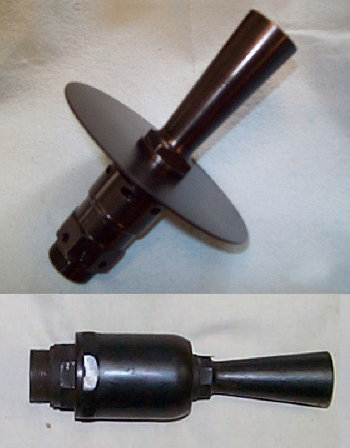
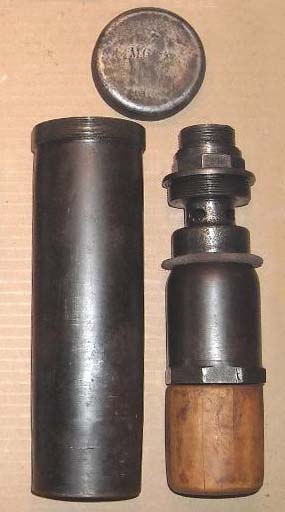
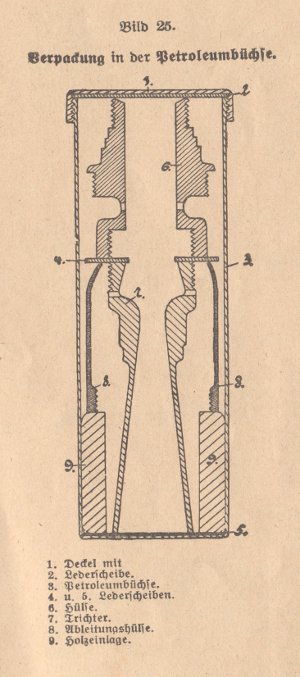
The booster assembly is subjected to very high temperatures during firing, and the expelled gasses and carbon build up quickly in the boosters orifices. The booster soaking can allowed the booster assembly to be stored in kerosene, or other cleaning solvent when not in use. Above left is a image of an MG08 booster over an MG08/15 booster, in the center is an original MG08/15 soaking can, at right is a scan of a diagram from an original manual demonstrating how to use the soaking can.
The MG08/15, being a "light" mobile machine gun, needed the belt feed to also be mobile. The solution was a Trommel (drum) with a removable spool in which a 100 round belt (cut from the standard 250 round belt) was wound. The Trommel is designed to open on a hinge to remove the spool and closed securely with a spring loaded latch. The drum was designed to slip over a special hanger that mounted to the right side of the gun below the feedblock. To prevent the belt from unrolling while being handled, a small lever with a tang engages a toothed ring on the rear of the drum housing. Once assembled, the lever needs to be lifted to free the spool to turn. Failing to lift the lever will cause the gun to jamb.

Spare drums were stored in pairs in wooden boxes that would be carried by the gunner's crew. In the photo below, the far left is an original double latch drum carrier, the two images to the right are a reproduction in use for IR63. The originals were most likely a white European pine, a hard wood, this reproduction is constructed of western white pine, the closest species of wood available here.

The MG08/15 burns through 400
rounds a minute, and therefore needs to be
supplied with copious amounts of ammo. The standard ammunition
carrier was a wood or metal box that held
250 round belts, for the MG08/15 it would have carried that, or
two 100-round belts to refill the drums. The
interior dimensions of the both boxes would have been nearly the
same, the wood box being larger due to the thicker
wood. The metal cans had carry handles offset to one side, this
allows the handles of two boxes to come together
when the boxes are placed side-by-side — they can then be easily
grasped by one hand - thus one soldier could easily
carry 4 ammo boxes — or 1000 rounds! There was also a less common
500 round ammo can, double wide, with a divider lengthwise to create
two separate compartments, each containing a 250 round belt.
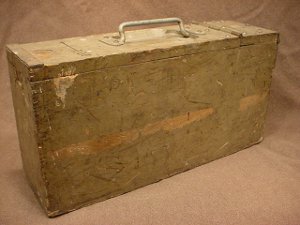
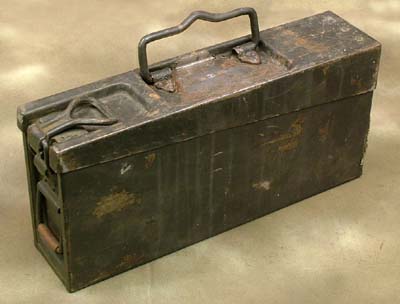
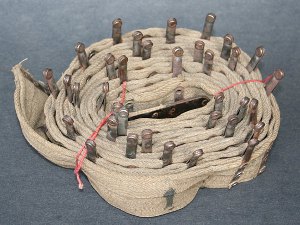
Above left: An original wood ammunition box. Middle: A metal ammunition box (similar to some post WWI boxes and some WWII era boxes, and are easily found for our use). Right: An original 100-round cloth belt.
The MG08/15 is water cooled, the water contained in a cylinder that surrounds the barrel, asbestos rope seals at the front and rear of the barrel retain the water. The excess heat is more than sufficient to boil the water, so the gun is equipped with a steamport. A hose connects with a coupler to the end of the steamport nozzle to direct the steam to a steam chest where it cools and condenses back into water. When the water level drops in the gun, the collected water is poured back into the water jacket through a small water plug that screws into the jacket. The steam chest is a sheet iron container, identical is size to the 250 round metal ammo can with the same offset handle and the chest is lined with zinc to prevent rust.
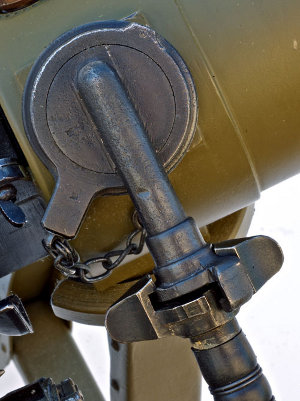
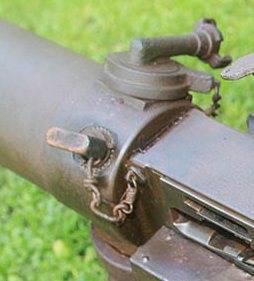
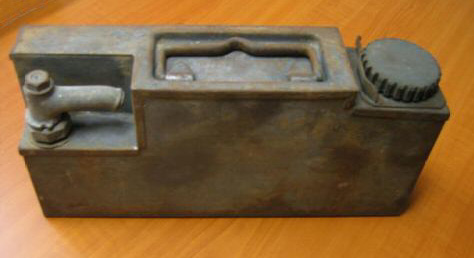
Above left: Steam port with hose and coupler. Middle: A left side view of the gun showing the filler cap (the cap has a thumb twist with a hardwood cover, fillers with the wood intact are rare). Right: An original steam chest.
The MG 08/15 is still a maxim, so while it may have been one of the first automatic weapons, it was also large, heavy, cumbersome, and even when new, required a lot of maintenance and care, so gunners and crew would carry toolboxes with some basic tools. One of these, carrying cleaning and lubricating fluids, was the basic 500 round ammo can, minus the center lengthwise divider, but with an added transverse divider. Below left find a diagram from a training manual showing the internal layout, and the two photos to the right are of an original.
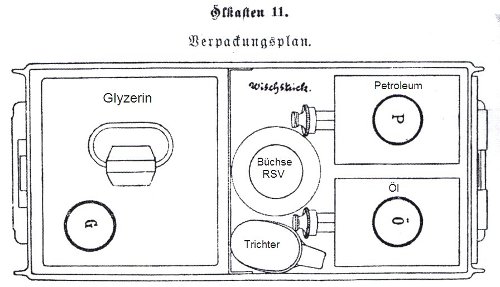
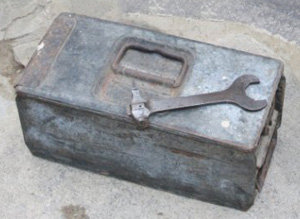
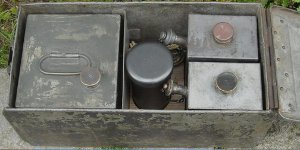
For repairs on the move, the MG08/15 operator was equipped with a leather or canvas toolbox with a shoulder strap that contained a tool roll with various tools necessary for simple field repairs to keep the gun running in battle.
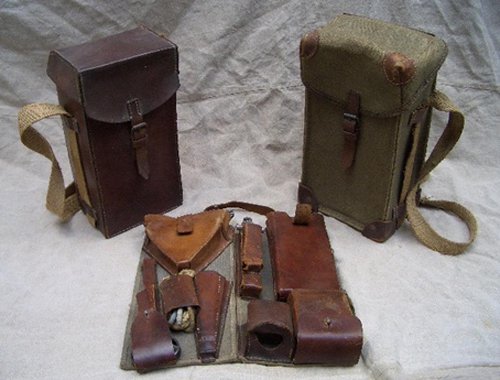
Above left is a picture of both original leather box and the ersatz canvas box, with the canvas and leather tool roll. At right is a reproduction set, custom made by Steve Fisher, in leather. The tool roll was not and exact copy but rather configured to hold tools needed to service a blank adapted weapon at tactical events.
One rare accessory is a small transport wagon. Photo evidence is scant, but enough do exist to show that there was a purpose built transport cart/wagon that could accommodate ammo boxes, tool boxes, a Trommel carrier and of course, the weapon itself, with the detachable bipod strapped to a holder on the end of the wagon.
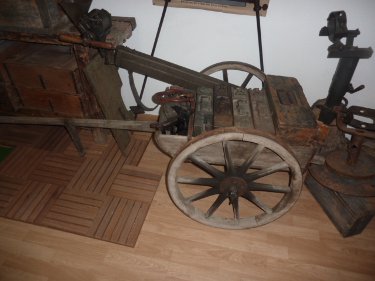
An original wagon in a personal collection.
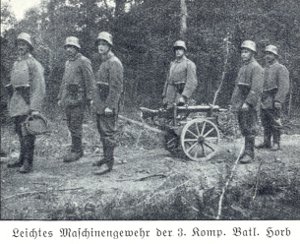
An original photo of a MG crew with wagon
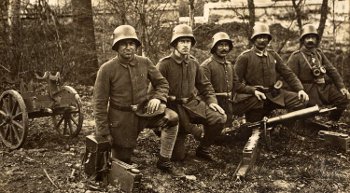
A period photo with a wagon in the upper left of the photo.
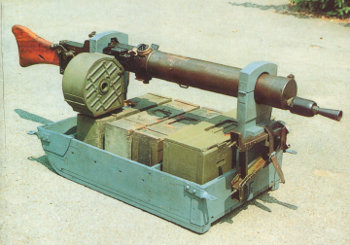
A photo from the publication Waffen Revue showing an original wagon, oddly without its wheel assembly.
Below find images of a repro wagon in use for IR63. Some of the details are an educated guess or were taken from better images of Reichswehr period wagons which were similar. The originals were most likely a white European pine, a hard wood, but this reproduction is a combination of oak and poplar.
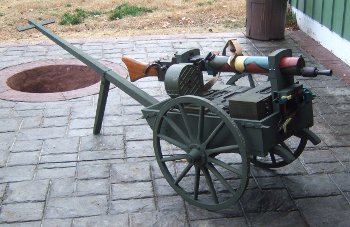
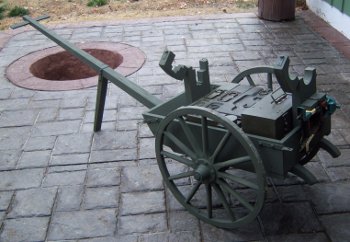
The original photo from Waffen Revue shows three wood 250-round ammo boxes and the wood Trommel carrier stored under the weapon. Based on these dimensions, the reproduction wagon can carry this load as well, but a more practical use (for the renactor) is two 250-round metal ammo boxes, a steam chest, a metal tool box (or double ammo box) and the Trommel carrier.
BIBLIOGRAPHY
Musgrave, Daniel D., German
Machineguns, (Ironside
International Publishers, Alexandria, Virginia: 1992)
Click Here to download a complete scan of an original 1918 dated manual for the MG08/15
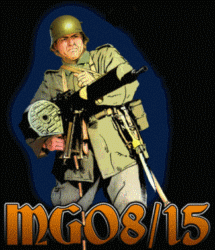
For MG08/15 themed merchandise, including detailed exploded view posters, please visit our Cafepress store by clicking the image below:
